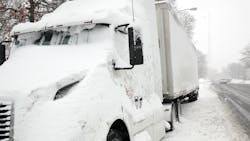The windshield wipers on Tom Bray’s Navistar International 9670 Cabover scraped and squeaked across the glass as he eked his way up Interstate 70 near Vail, Colorado, one September day in the late 1980s. That’s too bad, Bray thought as he maneuvered past yet another accident, red and yellow emergency lights flashing through the driving weather. The Colorado resort town was truly picturesque this time of year—if he could have seen any of it. Instead, snow piled onto the roadway and columns of pine trees flanking it, blanketing the slopes of the Rocky Mountains, so all Bray could see was a sea of red brake lights.
“There were wrecks and it was just a mess,” recalled Bray, now a consultant for J.J. Keller & Associates. “And the Colorado [Department of Transportation], rather than mess with it, just said, ‘We’re shutting the road down until we can get it cleaned up right and get everything out of the way.’ That ended up taking three days.”
For Bray, that meant three days at a snowed-in rest area, not knowing if he would have enough fuel to heat the cab over that time and get moving again when the weather cleared. But luckily, since Bray was well-prepared for his impromptu ski town stay, he had no trouble keeping himself warm and ensuring that his deck was clear of snow and his air lines and fuel were free of ice.
Blizzards not withstanding, truckers are always at risk for an emergency roadside event. Fleets average 42,459 miles between roadside repairs, according to the most recent Truckload Vertical Benchmark Study, a report put out by American Trucking Associations’ Technology & Maintenance Council and FleetNet America. That means if a truck travels 100,000 miles a year, the odds are the driver will have at least two roadside events. And, as Bray can attest, even in an early autumn breakdown, external forces could jeopardize the safety of the driver and create a major downtime issue. So, how do fleets ensure that their drivers can get off the road and hasten repairs by reaching service centers when they run into problems? And how can they stay as safe and comfortable as possible when they cannot?
The Department of Transportation regulates this to an extent, but “beyond that, there’s a lot of things that drivers should carry,” Bray advised.
And while an extended breakdown affects the driver the most, the whole operation is impacted, so the entire team should take some accountability in ensuring cabs are equipped with the right tools to handle potential hazards.
To discern what those right tools are, we reached out to several sources to find what an emergency tool kit should have and why it can really be a lifesaver, or at the very least, an uptime saver.
Tools required by law
“The most important thing drivers should have on hand is proper safety equipment,” said Eric Daniels, VP of truck care, Love’s Travel Stops. “Triangles, [a] fire extinguisher, and [a] high-visibility vest should be standard.”
Indeed, Title 49 of the Code of Federal Regulations states that all trucks and tractors must have fire extinguishers, with hazmat haulers having stricter stipulations. Extinguishers may last a long time, with an average lifespan of more than 10 years, but fleets should institute a regular inspection to verify they will work when needed.
Additionally, all vehicles must have spare fuses, warning devices (such as triangles), six flares, three liquid-burning flares, and red flags.Basic tool set
Whether in rain or shine, drivers sometimes find themselves the victim of small issues that, while not critically damaging to their vehicle, are enough to present them with an inspection violation.
“Drivers should have a basic tool set for fixes such as a loose mudflap or light change,” Daniels continued.
These tools can be fairly basic but may be the difference between driving freely or receiving an out-of-service violation from the Commercial Vehicle Safety Alliance (CVSA).
“You don’t need a whole [set of] craftsman tools—just some basic tools,” said Bob Seidl, driver training and development for Schneider, in a company-produced video on emergency tool kits. “We’re not asking you to be mechanics, but sometimes if all [you’ve] got to do is turn a wrench a little bit and [you’ll get] going again, well, [you should] turn that wrench.”Seidl said a couple of crescent wrenches, open box wrenches, screwdrivers, and a vice grip are good to have on hand. Meanwhile, Norita Taylor, director of public relations for the Owner-Operator Independent Drivers Association, also suggested drivers fill out their tool kit with pliers, electrical tape, duct tape, and bungee cords.
“The mechanical ability of the driver would determine if more tools would be justified [as well],” Taylor said.
Otherwise, combination tools and adjustable wrenches will allow a driver to switch out light bulbs, adjust trailer pins, and even tighten loose dashboards, door panels, and deck plates.
Tire and lighting violation protection
During 2022’s CVSA International Roadcheck, over 12,000 commercial vehicles were placed out of service. Of these violations, 19.4% were for tire problems, while 12.5% were for lights, placing both in the top five vehicle out-of-service violations. But an inspector violation isn’t the only way a vehicle might end up roadside.
“Tire breakdowns make up over 50% of all roadside breakdowns for our organization,” said Daniel Mustafa, director of technical services for TravelCenters of America. “And I think that’s going to reflect the industry as a whole.”
To avoid issues such as these, Bray recommended drivers have a few other tools to patch up lighting and tire issues. First and foremost, a tire gauge is a good friend to every driver and far more reliable than a tire bat. But if a driver is far from home and finds their tire pressure is lacking, what then? One option is for drivers to keep an air compressor in their vehicle. Heavy-duty units can be purchased both as parts of tire repair kits or on their own. But there’s another option as well.
“I, and a lot of my drivers, would carry air hoses called a trigger gladhand for the tractor-trailer driver,” Bray said. “You connect it into your trailer gladhand and use that to fill tires as needed around the truck.”
Meanwhile, if a driver knows the different kind of bulbs used in their warning lights, headlights, and signals, they can also save themselves an out-of-service violation by carrying spare bulbs on board.
Protective apparel
While a basic tool set can help get the job done and get a driver back on the road, making sure they are dressed to address issues safely, especially in bad weather or at night, is also critical.
“Start the list of things that drivers should have, and a lot of company policies [require that] you will have, with reflective, high-visibility clothing, whether it’s a vest or a jacket,” Bray recommended. “So, if [the driver does] have to get out of the vehicle on the road, whether it’s because of an accident or breakdown or whatever, they’re fully visible to everybody.”
Additionally, even drivers who don’t normally have eyewear may benefit from a pair of safety glasses to protect their eyes when making small adjustments under their vehicle. Neither of these items cost that much either, making them easy investments for drivers.
Basic survival
Another must-have for drivers is a good stock of non-perishable food, a case of water, and a first aid kit.
“If you’re planning on being stuck for any period of time, it wouldn’t be bad to have a little water and some food,” said Rick Clasby, executive director of the Utah Trucking Association.
All of these items should be able to last for long periods, both in the heat and the cold, depending on a driver’s regional routes. Bray personally recommended small sausages as well as spaghetti and meatballs, but canned soup, granola bars, and beef jerky are also cost-effective options.
With food safety taken care of, it’s also essential that drivers be prepared to handle physical ailments as well.
“When I was a driver or as a safety person, I didn’t hurt myself so much,” Bray said. “But I came across a lot of hurt people over time.”
Whether a fellow driver slices a finger in a winch or a motorist is involved in an accident on the road, a first-aid kit is critical for themselves and others. Luckily, a basic kit with dressing pads, disinfectant, Band -Aids, tape, and scissors are all easy purchases.
“On top of that, I would also add [that] it’s important to have something to charge your cell phone,” said John Hahn, captain of the Colorado State Patrol and commander of the Motor Carrier Safety section. “We’ve become so reliant on those over the years for a lot of reasons, but most importantly, if you need to reach out and call for help, [you need to make] sure that you have a phone that is charged.”
For drivers, that means making sure they have a spare charger cord and adapter for their vehicle as well as an external battery pack if something goes wrong with the truck’s powertrain.Winter weather preparation
Finally, although not every route takes place in seasonal areas, drivers in the Midwest and northern regions need to be prepared for winter weather. Even typically warmer areas can plunge to much colder temperatures overnight, let alone mountainous regions where warm clothing is key. Having a good jacket, gloves, and handwarmers may be the difference between a comfortable roadside experience and a miserable one.
“It’s important to have some extra clothes in the vehicle,” Hahn emphasized. “I always had an extra change of clothes thrown in the back of the vehicle when I worked the road as a state trooper.”
As far as staying warm goes, it would also behoove most drivers to make sure they have good bedding as well as warm clothes, including at least one emergency thermal blanket. Mylar blankets are cheap and light, making it a strong choice for easy packing.
“I [also] would add to carry tire chains for winter weather, which is the law in many states,” Taylor said in regard to preparing for winter driving.
States such as California, Colorado, and Idaho require that vehicles have chains in certain areas, with Colorado’s Department of Transportation mandating chains for medium- and heavy-duty vehicles.
But beyond making sure a vehicle’s tires are equipped for cold weather, drivers need to have the tools to make sure the internal workings of their trucks can handle drops in temperature, too. To that end, Mustafa recommended that drivers keep air line antifreeze on hand.
“If you find yourself in that situation where you have ice in the lines, and now air cannot get to the appropriate place at the appropriate time, this product, which is pretty much just alcohol, will thaw the truck out over time,” Mustafa explained. “So, at least while you’re stuck there waiting on the air to build, you can pour this product in the lines and help to thaw the vehicle out.”
In a similar vein, both Taylor and Mustafa advised drivers to keep fuel conditioners handy when heading into colder temperatures.
“When driving in the northern states, you will need a fuel additive that will prevent fuel gelling,” Taylor added. “Many times, a driver will fuel up in a southern state, which doesn’t have winter additives, and then drive north into cold weather.”
Also, if a fuel filter ends up waxing because of the cold, a driver may need to change it to get back on the road. However, this endeavor can be tricky, Mustafa warned.
“The driver can have the tools and equipment to change the fuel filter,” Mustafa explained. “[But] you do have to have the right filter wrenches for your specific filter, not necessarily by brand of the truck but by brand of the manufacturer of that filtration system.”
Finally, if snow is piling high as it was in the Vail blizzard that stranded Bray, drivers should have tools to free their trucks in slick conditions. Shovels and brooms are helpful to clear hard-to-reach areas of snow as well as keeping the underside of a truck clear if an asset doesn’t have a stack exhaust, while kitty litter can help tires grip the road.
“Kitty litter can be helpful to get traction,” Mustafa explained, “because with the weight of the engine, the driver, the cab, [and] all of those components up front on the vehicle, there’s no weight on the tires that actually drive the vehicle forward. So, on a very small incline, a truck without weight on the drive axle can get stuck.”
Is the investment worth it?
All told, if a fleet or driver invested in all of these supplies for their emergency kit, substituting a glandhand hose for the air compressor, they could conservatively spend as much as $450 for one vehicle. While this might seem expensive in light of the costs of fuel and maintenance, the price of a well-prepared emergency kit that may be able to get a vehicle to a shop instead of necessitating a tow could be worth its weight.
“Nightmarish would be some towing charges when broken down on the side of the road,” Taylor warned. “Many of them reach up to five figures!”
Meanwhile, FleetNet America estimates that at the beginning of 2020, the average cost to repair roadside breakdowns was $450, excluding towing, with that cost rising 16.6% from 2021 to 2022.
As with many cases, the cost-benefit analysis of having a well-equipped emergency kit versus not can vary fleet to fleet. But at least some of the expense is worth considering if it means a vehicle can make it to a service center instead of being towed, and that a driver can be comfortable and safe while doing so. Even if a fleet doesn’t require all of the items on this list, being sure to have the basics could be the difference between manageable downtime and a critical event.
About the Author

Alex Keenan
Alex Keenan is an Associate Editor for Fleet Maintenance magazine. She has written on a variety of topics for the past several years and recently joined the transportation industry, reviewing content covering technician challenges and breaking industry news. She holds a bachelor's degree in English from Colorado State University in Fort Collins, Colorado.

![“Triangles, [a] fire extinguisher, and [a] high-visibility vest should be standard,” said Eric Daniels, VP of truck care, Love’s Travel Stops. “Triangles, [a] fire extinguisher, and [a] high-visibility vest should be standard,” said Eric Daniels, VP of truck care, Love’s Travel Stops.](https://img.fleetmaintenance.com/files/base/ebm/fm/image/2022/11/16x9/Driver_places_triangles.62faa3b568cfc.6317b3cf16796.631b6bc059ab8.6373b750715a5.png?auto=format,compress&fit=max&q=45&w=250&width=250)

